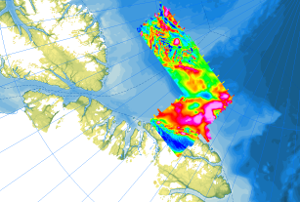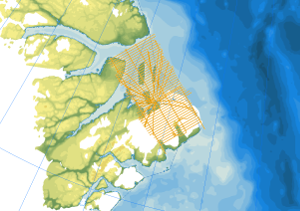Keyword
Aerogeophysik
106 record(s)
Provided by
Type of resources
Available actions
Topics
Keywords
Contact for the resource
Service types
-

Onshore geological field work combined with an onshore/offshore aeromagnetic survey was carried out during a joint expedition of the German BGR and the Canadian GSC to understand the structural architecture of the North American continental margin. The helicopter-borne magnetic survey of 2008 covered the northern coastal areas of Ellesmere Island and the adjacent marine areas. The survey was conducted with a line separation of 2 km and covered a 40 to 50 km wide swath offshore about parallel to the north coast of Ellesmere Island from Yelverton Bay in the west to Parr Bay east of Cape Columbia, the northernmost point of Canada. Between Yelverton Bay and M'Clintock Inlet, the survey extended about 40 to 50 km inland, which was the prime target area of the CASE 11 geological investigations. This section of mountainous terrain was flown in a “draped” mode to keep the distance to ground at approximately 1500 ft, same as over the offshore areas. During a 4-weeks period in May/June 2008, close to 8000 km of aeromagnetic line data were acquired, covering an area of 12000 km².
-

The study of the geodynamic evolution of the Arctic continental margin and opening of the Arctic Ocean represents a primary target of BGR research and is studied within the frame of the CASE programme. In addition to onshore geological investigations, BGR conducts airborne aeromagnetic surveys. The available service contains the results of aeromagnetic surveys from the CASE program as well as cooperation projects (PMAP, NARES & NOGRAM), which were obtained with helicopters or fixed-wing aircraft in the Arctic.
-

As part of the PMAP-CASE (Polar Margin Aeromagnetic Program - Circum-Arctic Structural Events) expeditions, two surveys were conducted in consecutive seasons in 1997 and 1998. Cooperating partners were the Department of National Defence (DND), GSC Ottawa and the Institute for Aerospace Research Ottawa (IAR-NRC). The surveys covered the areas of the northern continental margin of Greenland including the northern Nansen Land and western Johannes V. Jensen Land, as well as parts of the Lincoln Sea. The objective of the campaigns was to investigate the structures of the upper crust of the Morris Jesup Plateau and the correlation of magnetic anomalies with known structures and geologic units on land (Franklinian Basin, Kap Washington volcanics, and volcanic dyke swarms). Airborne magnetic surveys (Convair 580) were conducted with a 3 km flight line spacing, and control lines were flown every 30 km. Data were recorded at a constant flight altitude of 300 m above ground. Approximately 30000 km of line data were collected during the two expeditions, covering an area of 73000 km².
-

As part of the expedition CASE 20, geological fieldwork and an aeromagnetic survey were conducted in order to study the architecture and structure of the present continental margin of Northeast Greenland. The helicopter-borne magnetic survey in July and August 2018 covered the coastal areas between Independence Fiord and Kronprins Christian Land. During a 2-weeks period nearly 6500 km of aeromagnetic line data were collected covering an area of 17000 km². The distance between the individual lines was 4 km and control profiles were flown every 20-30 km. The aeromagnetic data were recorded by a magnetometer, which was towed approx. 30 m beneath the helicopter.
-

During the German-Canadian Nares Strait Expedition in 2001, an aeromagnetic survey was carried out across the northern part of the Nares Strait including the Hall Basin, Judge Daly Promontory and in Robeson Channel in cooperation with the Canadian GSC. The aim of the research was to detect and localize the Wegener Fault, a transform fault between Ellesmere Island and NW Greenland, which is closely linked to the opening of the North Atlantic and the Arctic Ocean. The helicopter-borne magnetic survey NARES I (Robeson Channel) was carried out with a flight line spacing of 2 km, and control profiles were flown every 10 km. During the expedition, 5470 km of line data were collected. The aeromagnetic data were recorded by a magnetometer, which was towed approx. 25 m beneath the helicopter and recorded at a constant altitude of 305 m (1000 ft) above ground.
-

The study of the geodynamic evolution of the Arctic continental margin and opening of the Arctic Ocean represents a primary target of BGR research and is studied within the frame of the CASE programme. In addition to onshore geological investigations, BGR conducts airborne aeromagnetic surveys. The available series contains the results of aeromagnetic surveys from the CASE program as well as cooperation projects (PMAP, NARES & NOGRAM), which were obtained with helicopters or fixed-wing aircraft in the Arctic.
-

In May/June 2001, as part of the expedition NARES I, an aeromagnetic survey was carried out in the area of the eastern Kane Basin in cooperation with the Canadian GSC, in addition to the survey over the Robeson Channel and parallel to marine geophysical investigations with the Canadian icebreaker Louis S. St. Laurent. Another survey, NARES II, was conducted from Alexandra Fiord in 2003 and covered coastal areas of Ellesmere Island and the western Kane Basin. The aim of the research was to detect and localize the Wegener Fault, a transform fault between Ellesmere Island and NW Greenland, which is closely linked to the opening of the North Atlantic and the Arctic Ocean. The helicopter-borne magnetic surveys NARES I + II (Kane Basin) were carried out with a flight line spacing of 2 km, and control profiles were flown every 10 km. During the two expeditions, 11806 km of line data were collected (3573 km in 2001, and 8333 km in 2003), covering an area of approximately 20000 km². The aeromagnetic data were recorded by a magnetometer, which was towed approx. 25 m beneath the helicopter.
-

As part of the CASE 12 expedition, geological fieldwork and an aeromagnetic survey were conducted on Ellesmere Island (Canadian Arctic) in the summer of 2011. The helicopter-borne magnetic survey covered the ice-free areas between Vendom Fiord and Strathcona Fiord in the west and the ice-covered mountain ranges of the Inglefield Uplift in the east. With a total flight time of approx. 35 hours, 4200 line kilometres were flown covering a total area of 6000 km². The distance between the individual lines was 2 km, and control profiles perpendicular to the individual lines were flown every 10 km. The aeromagnetic data were recorded by a magnetometer, which was towed approx. 30 m beneath the helicopter.
-

In 1998, as part of the expedition NOGRAM I (Northern Gravity, Radio Echo Sounding and Magnetics), a flight campaign was carried out over the Lincoln Sea north of Greenland with the Polar 2 aircraft (Dornier 228-100) in cooperation with the Alfred Wegener Institute Helmholtz Center for Polar and Marine Research. A second flight campaign NOGRAM II took place in 2011 with the Polar 5 (Basler BT-67) over the Wandel Sea north of Greenland. The aim of the research was the structure and architecture of the upper Earth’s crust underneath the ice-covered offshore areas of the Morris Jesup Plateau and coastal waters north of Greenland. The airborne magnetic surveys were carried out with a flight line spacing of 3 km, and control profiles were flown every 30 km. During the two expeditions, 33000 km of line data were collected (16000 km in 1998, and 17000 km in 2011).
-
.png)
The WMS D-AERO (INSPIRE) comprises airborne geophysical surveys for mapping the shallow subsurface in Germany. Since the eighties BGR carries out helicopter borne measurements in Germany as well as in neighbouring and distant countries. In particular a series of continuous areas on the German North Sea coast are flown during the last years within the context of the D-AERO project. The helicopter of type Sikorsky S-76B is operated for the airborne geophysical survey of the earth's subsurface. Usually airborne electromagnetic, magnetic and radiometric measurements are carried out. According to the Data Specification on Geology (D2.8.II.4_v3.0, sub-theme Geophysics) the information with respect to the airborne geophysical surveys is INSPIRE-compliant. The WMS D-AERO (INSPIRE) contains for each airborne geophysical survey one layer, e.g. GE.flightLine.G081Cuxhaven. The flightlines are displayed correspondingly to the INSPIRE portrayal rules. Via the getFeatureInfo request, the user obtains the content of the INSPIRE attributes platformType und profileType. Additionally, the WMS contains a campaign layer (GE.airborneGeophysicalSurvey) with the INSPIRE attributes campaignType and surveyType.
 www.geodatenkatalog.de (S3L)
www.geodatenkatalog.de (S3L)